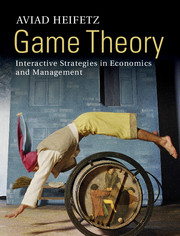Book contents
- Frontmatter
- Contents
- Foreword
- Part I Strategic interactions as games
- Part II Basic solution concepts for strategic form games
- Part III Prominent classes of strategic form games
- Part IV Uncertainty and mixed strategies
- Part V Advanced topics in strategic form games
- Part VI Dynamic games
- 18 Extensive form games
- 19 Non-credible threats, subgame perfect equilibrium and backward induction
- 20 Commitment
- 21 Backward induction
- 22 Moves of nature
- Part VII Repeated games
- Index
- References
20 - Commitment
from Part VI - Dynamic games
Published online by Cambridge University Press: 05 August 2012
- Frontmatter
- Contents
- Foreword
- Part I Strategic interactions as games
- Part II Basic solution concepts for strategic form games
- Part III Prominent classes of strategic form games
- Part IV Uncertainty and mixed strategies
- Part V Advanced topics in strategic form games
- Part VI Dynamic games
- 18 Extensive form games
- 19 Non-credible threats, subgame perfect equilibrium and backward induction
- 20 Commitment
- 21 Backward induction
- 22 Moves of nature
- Part VII Repeated games
- Index
- References
Summary
Commitment to action
In section 19.3.1, we described the Stackelberg model, in which one firm is the first to decide what quantity to produce, while the other firm decides what quantity it will produce only after having observed how much the first firm has produced. We saw that at the unique subgame perfect equilibrium of the game, the leading firm effectively chooses the combination of quantities that will maximize its profits from among all the combinations of quantities on its rival’s reaction curve. But in this combination of quantities, the quantity that the first firm produces does not constitute a best reply to the quantity that the second firm ultimately produces: if, after the second firm has chosen its strategy at a Stackelberg equilibrium, the first firm were to get a chance to change its mind and produce a smaller quantity than it had already produced, then it would certainly prefer to do so. Thus, the leading firm’s advantage is reflected in the fact that by its action, it can commit and bind itself to an action that at the end of the day is not necessarily optimal for it. The leading firm’s loss redounds to its advantage, since its commitment to an “over-aggressive” strategy leads its rival to behave “submissively.”
In the decision problem of a unique decision maker, the decision maker can derive no advantage from deciding to adopt an action which will prove, in retrospect, to have been suboptimal for her. One of the most important insights of game theory is that in strategic situations, a player’s ability to commit to her strategy – a strategy that is not necessarily optimal, given the reactions of her rivals – can secure her an important advantage.
Information
- Type
- Chapter
- Information
- Game TheoryInteractive Strategies in Economics and Management, pp. 333 - 352Publisher: Cambridge University PressPrint publication year: 2012
References
Accessibility standard: Unknown
Why this information is here
This section outlines the accessibility features of this content - including support for screen readers, full keyboard navigation and high-contrast display options. This may not be relevant for you.Accessibility Information
- 1
- Cited by
